Business Law Report: English Legal System, Obligations, and Cases
VerifiedAdded on 2020/07/22
|14
|4648
|33
Report
AI Summary
This report provides a detailed analysis of business law within the United Kingdom, with a specific emphasis on the English legal system. It explores the system's sources, including legislation, court decisions, and government's role in law-making and implementation. The report delves into employer obligations concerning occupational safety, health, workers' compensation, harassment, and equal opportunities. Furthermore, it examines the effects of employment and contract law on businesses. The report analyzes legal solutions in various cases, evaluates the impact of legal solutions on business, and compares alternative dispute resolution methods. The report also covers the evaluation of legal advice and provides a comprehensive overview of business law principles and their practical applications.
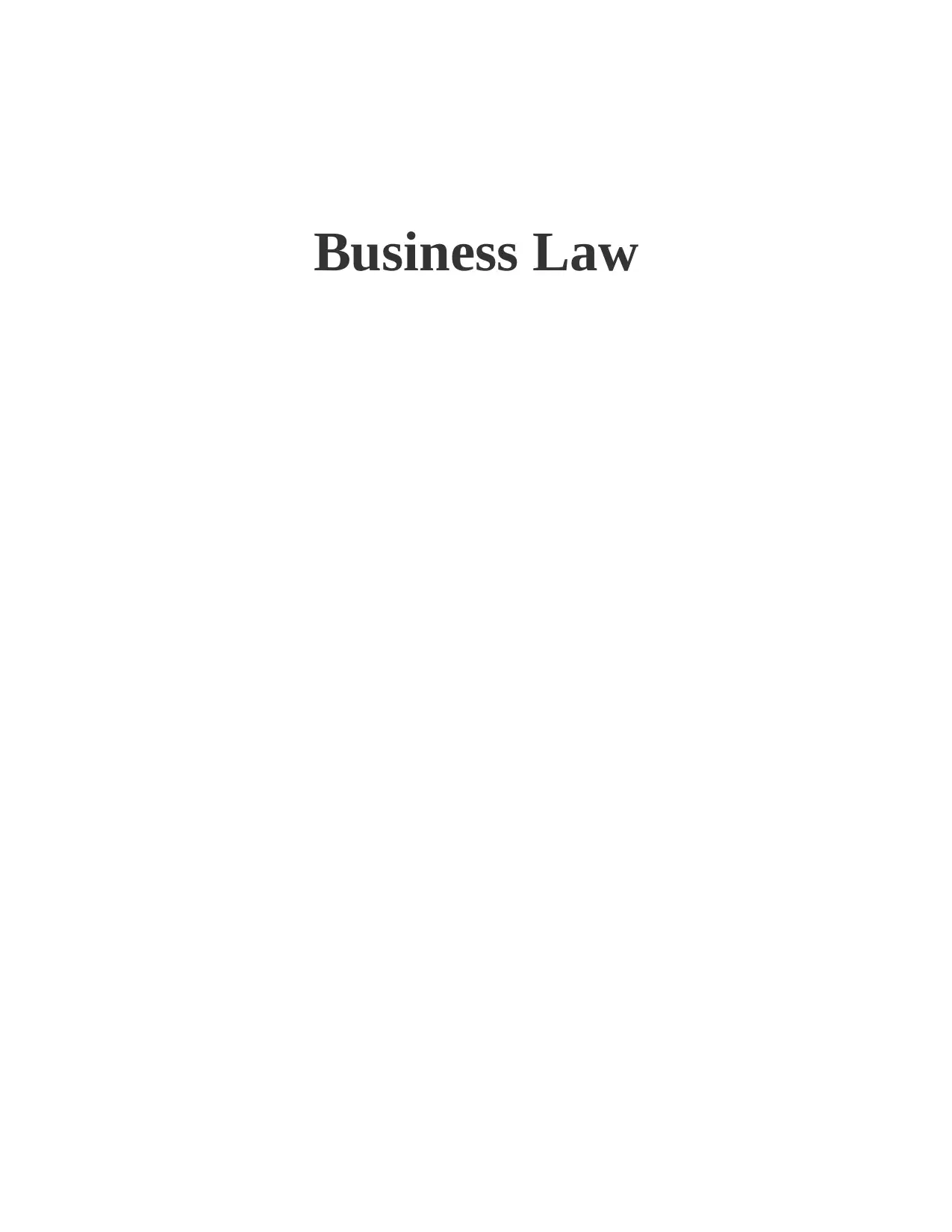
Business Law
Paraphrase This Document
Need a fresh take? Get an instant paraphrase of this document with our AI Paraphraser
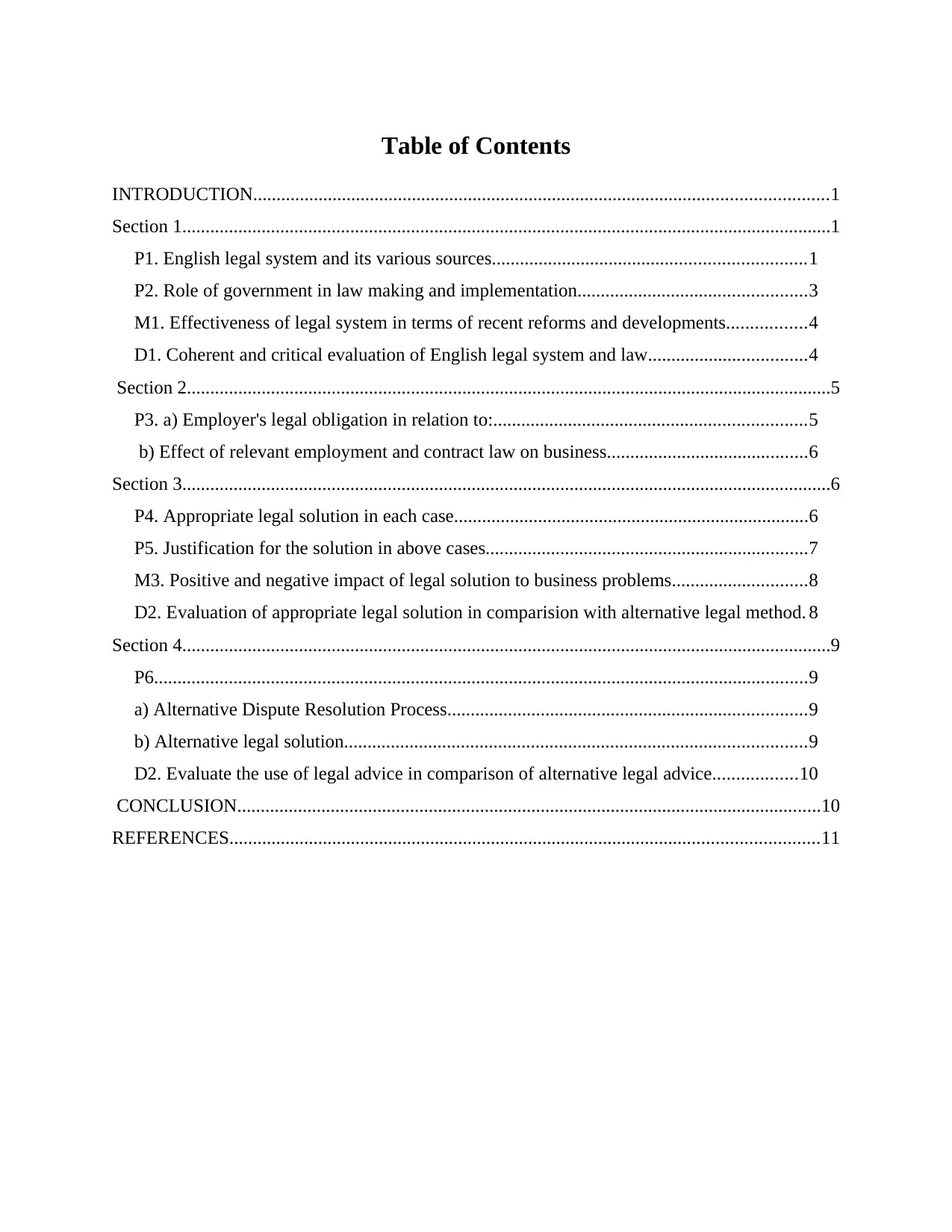
Table of Contents
INTRODUCTION...........................................................................................................................1
Section 1...........................................................................................................................................1
P1. English legal system and its various sources...................................................................1
P2. Role of government in law making and implementation.................................................3
M1. Effectiveness of legal system in terms of recent reforms and developments.................4
D1. Coherent and critical evaluation of English legal system and law..................................4
Section 2..........................................................................................................................................5
P3. a) Employer's legal obligation in relation to:...................................................................5
b) Effect of relevant employment and contract law on business...........................................6
Section 3...........................................................................................................................................6
P4. Appropriate legal solution in each case............................................................................6
P5. Justification for the solution in above cases.....................................................................7
M3. Positive and negative impact of legal solution to business problems.............................8
D2. Evaluation of appropriate legal solution in comparision with alternative legal method. 8
Section 4...........................................................................................................................................9
P6............................................................................................................................................9
a) Alternative Dispute Resolution Process.............................................................................9
b) Alternative legal solution...................................................................................................9
D2. Evaluate the use of legal advice in comparison of alternative legal advice..................10
CONCLUSION.............................................................................................................................10
REFERENCES..............................................................................................................................11
INTRODUCTION...........................................................................................................................1
Section 1...........................................................................................................................................1
P1. English legal system and its various sources...................................................................1
P2. Role of government in law making and implementation.................................................3
M1. Effectiveness of legal system in terms of recent reforms and developments.................4
D1. Coherent and critical evaluation of English legal system and law..................................4
Section 2..........................................................................................................................................5
P3. a) Employer's legal obligation in relation to:...................................................................5
b) Effect of relevant employment and contract law on business...........................................6
Section 3...........................................................................................................................................6
P4. Appropriate legal solution in each case............................................................................6
P5. Justification for the solution in above cases.....................................................................7
M3. Positive and negative impact of legal solution to business problems.............................8
D2. Evaluation of appropriate legal solution in comparision with alternative legal method. 8
Section 4...........................................................................................................................................9
P6............................................................................................................................................9
a) Alternative Dispute Resolution Process.............................................................................9
b) Alternative legal solution...................................................................................................9
D2. Evaluate the use of legal advice in comparison of alternative legal advice..................10
CONCLUSION.............................................................................................................................10
REFERENCES..............................................................................................................................11
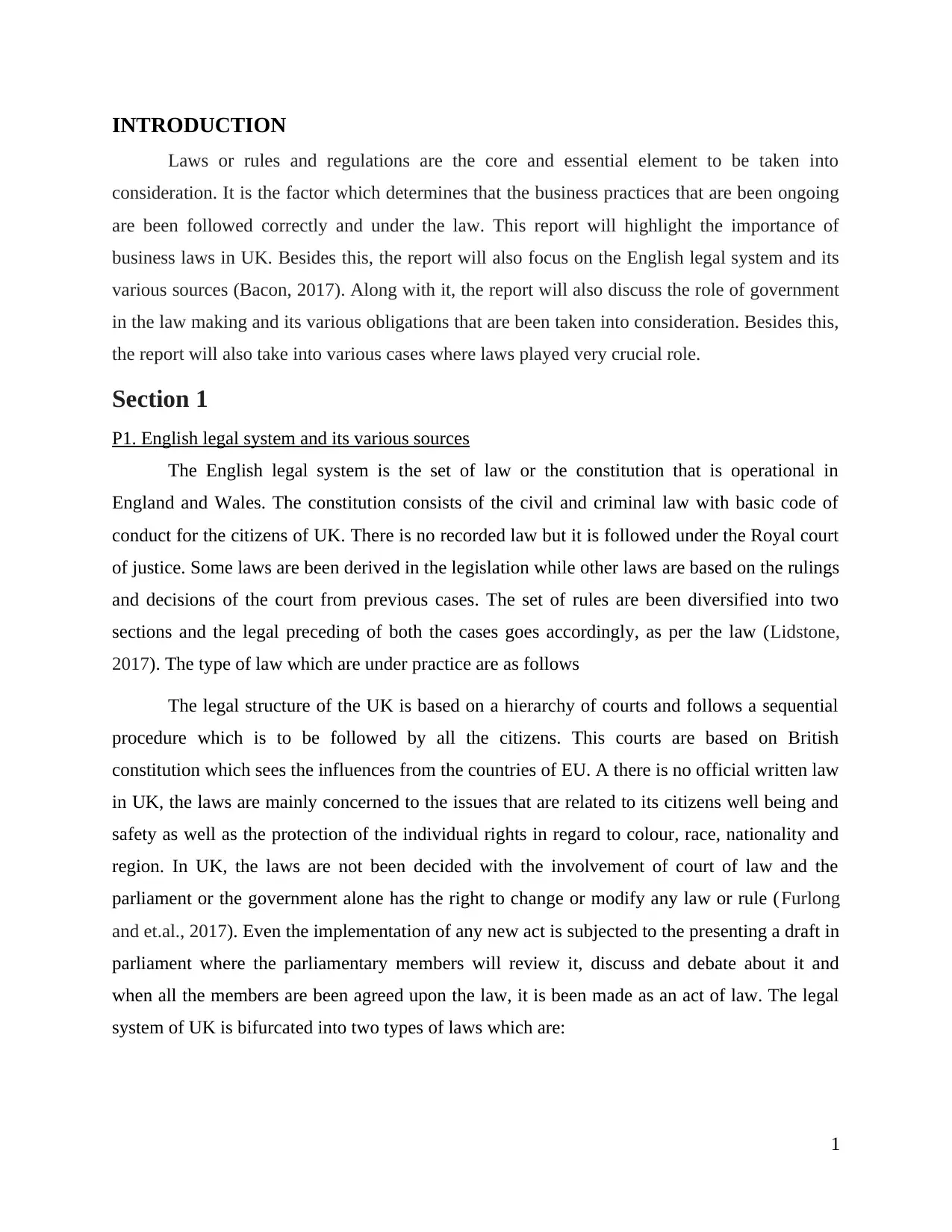
INTRODUCTION
Laws or rules and regulations are the core and essential element to be taken into
consideration. It is the factor which determines that the business practices that are been ongoing
are been followed correctly and under the law. This report will highlight the importance of
business laws in UK. Besides this, the report will also focus on the English legal system and its
various sources (Bacon, 2017). Along with it, the report will also discuss the role of government
in the law making and its various obligations that are been taken into consideration. Besides this,
the report will also take into various cases where laws played very crucial role.
Section 1
P1. English legal system and its various sources
The English legal system is the set of law or the constitution that is operational in
England and Wales. The constitution consists of the civil and criminal law with basic code of
conduct for the citizens of UK. There is no recorded law but it is followed under the Royal court
of justice. Some laws are been derived in the legislation while other laws are based on the rulings
and decisions of the court from previous cases. The set of rules are been diversified into two
sections and the legal preceding of both the cases goes accordingly, as per the law (Lidstone,
2017). The type of law which are under practice are as follows
The legal structure of the UK is based on a hierarchy of courts and follows a sequential
procedure which is to be followed by all the citizens. This courts are based on British
constitution which sees the influences from the countries of EU. A there is no official written law
in UK, the laws are mainly concerned to the issues that are related to its citizens well being and
safety as well as the protection of the individual rights in regard to colour, race, nationality and
region. In UK, the laws are not been decided with the involvement of court of law and the
parliament or the government alone has the right to change or modify any law or rule ( Furlong
and et.al., 2017). Even the implementation of any new act is subjected to the presenting a draft in
parliament where the parliamentary members will review it, discuss and debate about it and
when all the members are been agreed upon the law, it is been made as an act of law. The legal
system of UK is bifurcated into two types of laws which are:
1
Laws or rules and regulations are the core and essential element to be taken into
consideration. It is the factor which determines that the business practices that are been ongoing
are been followed correctly and under the law. This report will highlight the importance of
business laws in UK. Besides this, the report will also focus on the English legal system and its
various sources (Bacon, 2017). Along with it, the report will also discuss the role of government
in the law making and its various obligations that are been taken into consideration. Besides this,
the report will also take into various cases where laws played very crucial role.
Section 1
P1. English legal system and its various sources
The English legal system is the set of law or the constitution that is operational in
England and Wales. The constitution consists of the civil and criminal law with basic code of
conduct for the citizens of UK. There is no recorded law but it is followed under the Royal court
of justice. Some laws are been derived in the legislation while other laws are based on the rulings
and decisions of the court from previous cases. The set of rules are been diversified into two
sections and the legal preceding of both the cases goes accordingly, as per the law (Lidstone,
2017). The type of law which are under practice are as follows
The legal structure of the UK is based on a hierarchy of courts and follows a sequential
procedure which is to be followed by all the citizens. This courts are based on British
constitution which sees the influences from the countries of EU. A there is no official written law
in UK, the laws are mainly concerned to the issues that are related to its citizens well being and
safety as well as the protection of the individual rights in regard to colour, race, nationality and
region. In UK, the laws are not been decided with the involvement of court of law and the
parliament or the government alone has the right to change or modify any law or rule ( Furlong
and et.al., 2017). Even the implementation of any new act is subjected to the presenting a draft in
parliament where the parliamentary members will review it, discuss and debate about it and
when all the members are been agreed upon the law, it is been made as an act of law. The legal
system of UK is bifurcated into two types of laws which are:
1
⊘ This is a preview!⊘
Do you want full access?
Subscribe today to unlock all pages.

Trusted by 1+ million students worldwide
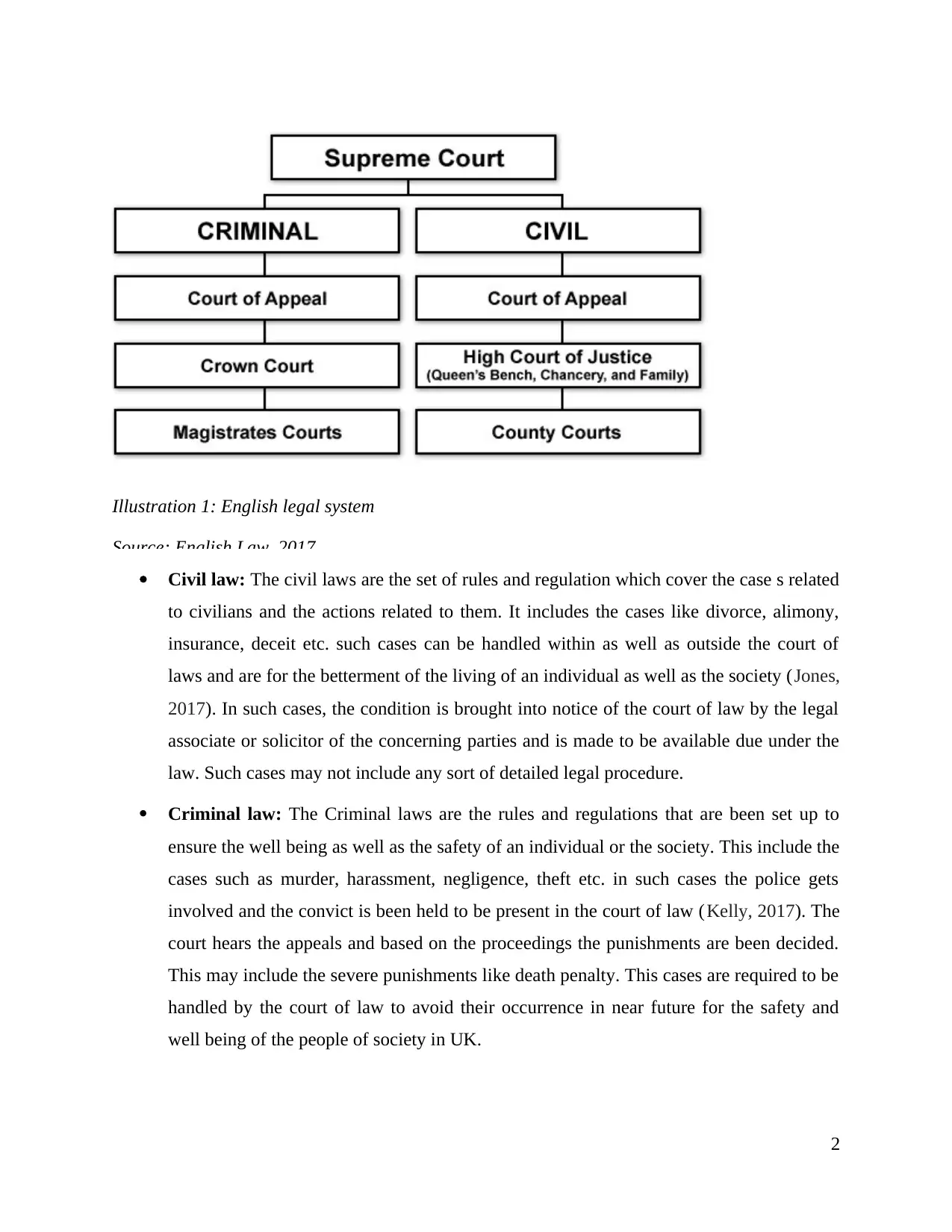
Illustration 1: English legal system
Source: English Law, 2017
Civil law: The civil laws are the set of rules and regulation which cover the case s related
to civilians and the actions related to them. It includes the cases like divorce, alimony,
insurance, deceit etc. such cases can be handled within as well as outside the court of
laws and are for the betterment of the living of an individual as well as the society (Jones,
2017). In such cases, the condition is brought into notice of the court of law by the legal
associate or solicitor of the concerning parties and is made to be available due under the
law. Such cases may not include any sort of detailed legal procedure.
Criminal law: The Criminal laws are the rules and regulations that are been set up to
ensure the well being as well as the safety of an individual or the society. This include the
cases such as murder, harassment, negligence, theft etc. in such cases the police gets
involved and the convict is been held to be present in the court of law (Kelly, 2017). The
court hears the appeals and based on the proceedings the punishments are been decided.
This may include the severe punishments like death penalty. This cases are required to be
handled by the court of law to avoid their occurrence in near future for the safety and
well being of the people of society in UK.
2
Source: English Law, 2017
Civil law: The civil laws are the set of rules and regulation which cover the case s related
to civilians and the actions related to them. It includes the cases like divorce, alimony,
insurance, deceit etc. such cases can be handled within as well as outside the court of
laws and are for the betterment of the living of an individual as well as the society (Jones,
2017). In such cases, the condition is brought into notice of the court of law by the legal
associate or solicitor of the concerning parties and is made to be available due under the
law. Such cases may not include any sort of detailed legal procedure.
Criminal law: The Criminal laws are the rules and regulations that are been set up to
ensure the well being as well as the safety of an individual or the society. This include the
cases such as murder, harassment, negligence, theft etc. in such cases the police gets
involved and the convict is been held to be present in the court of law (Kelly, 2017). The
court hears the appeals and based on the proceedings the punishments are been decided.
This may include the severe punishments like death penalty. This cases are required to be
handled by the court of law to avoid their occurrence in near future for the safety and
well being of the people of society in UK.
2
Paraphrase This Document
Need a fresh take? Get an instant paraphrase of this document with our AI Paraphraser
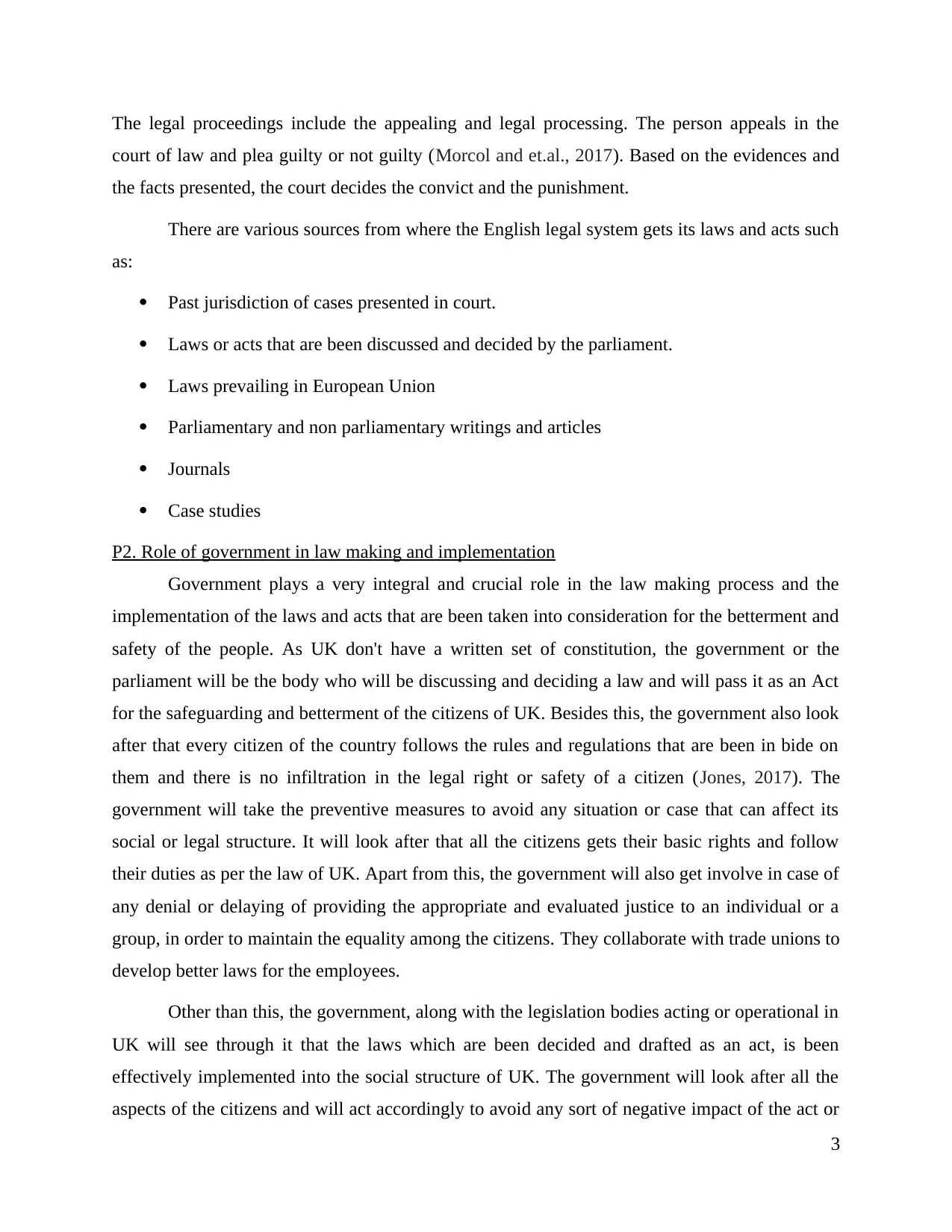
The legal proceedings include the appealing and legal processing. The person appeals in the
court of law and plea guilty or not guilty (Morcol and et.al., 2017). Based on the evidences and
the facts presented, the court decides the convict and the punishment.
There are various sources from where the English legal system gets its laws and acts such
as:
Past jurisdiction of cases presented in court.
Laws or acts that are been discussed and decided by the parliament.
Laws prevailing in European Union
Parliamentary and non parliamentary writings and articles
Journals
Case studies
P2. Role of government in law making and implementation
Government plays a very integral and crucial role in the law making process and the
implementation of the laws and acts that are been taken into consideration for the betterment and
safety of the people. As UK don't have a written set of constitution, the government or the
parliament will be the body who will be discussing and deciding a law and will pass it as an Act
for the safeguarding and betterment of the citizens of UK. Besides this, the government also look
after that every citizen of the country follows the rules and regulations that are been in bide on
them and there is no infiltration in the legal right or safety of a citizen (Jones, 2017). The
government will take the preventive measures to avoid any situation or case that can affect its
social or legal structure. It will look after that all the citizens gets their basic rights and follow
their duties as per the law of UK. Apart from this, the government will also get involve in case of
any denial or delaying of providing the appropriate and evaluated justice to an individual or a
group, in order to maintain the equality among the citizens. They collaborate with trade unions to
develop better laws for the employees.
Other than this, the government, along with the legislation bodies acting or operational in
UK will see through it that the laws which are been decided and drafted as an act, is been
effectively implemented into the social structure of UK. The government will look after all the
aspects of the citizens and will act accordingly to avoid any sort of negative impact of the act or
3
court of law and plea guilty or not guilty (Morcol and et.al., 2017). Based on the evidences and
the facts presented, the court decides the convict and the punishment.
There are various sources from where the English legal system gets its laws and acts such
as:
Past jurisdiction of cases presented in court.
Laws or acts that are been discussed and decided by the parliament.
Laws prevailing in European Union
Parliamentary and non parliamentary writings and articles
Journals
Case studies
P2. Role of government in law making and implementation
Government plays a very integral and crucial role in the law making process and the
implementation of the laws and acts that are been taken into consideration for the betterment and
safety of the people. As UK don't have a written set of constitution, the government or the
parliament will be the body who will be discussing and deciding a law and will pass it as an Act
for the safeguarding and betterment of the citizens of UK. Besides this, the government also look
after that every citizen of the country follows the rules and regulations that are been in bide on
them and there is no infiltration in the legal right or safety of a citizen (Jones, 2017). The
government will take the preventive measures to avoid any situation or case that can affect its
social or legal structure. It will look after that all the citizens gets their basic rights and follow
their duties as per the law of UK. Apart from this, the government will also get involve in case of
any denial or delaying of providing the appropriate and evaluated justice to an individual or a
group, in order to maintain the equality among the citizens. They collaborate with trade unions to
develop better laws for the employees.
Other than this, the government, along with the legislation bodies acting or operational in
UK will see through it that the laws which are been decided and drafted as an act, is been
effectively implemented into the social structure of UK. The government will look after all the
aspects of the citizens and will act accordingly to avoid any sort of negative impact of the act or
3
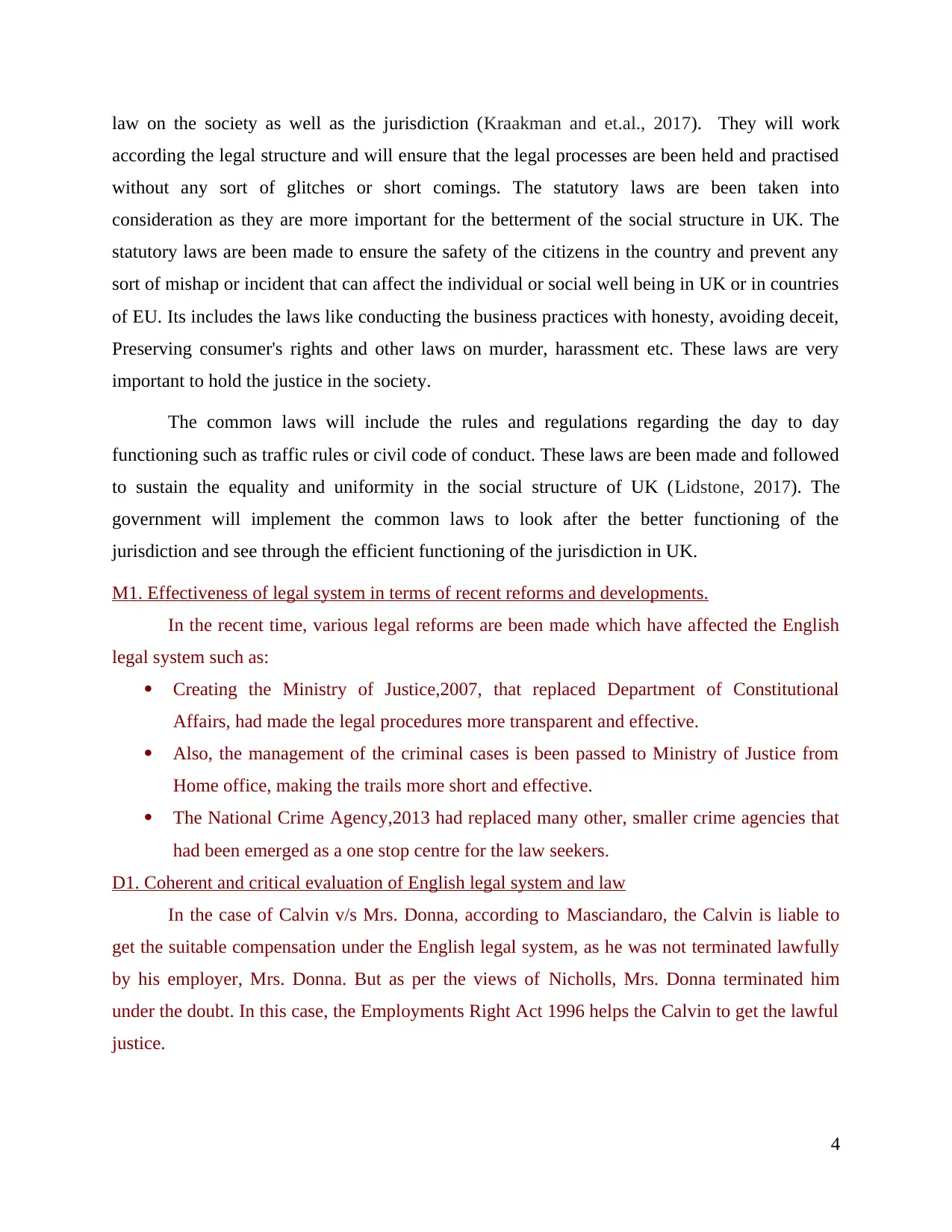
law on the society as well as the jurisdiction (Kraakman and et.al., 2017). They will work
according the legal structure and will ensure that the legal processes are been held and practised
without any sort of glitches or short comings. The statutory laws are been taken into
consideration as they are more important for the betterment of the social structure in UK. The
statutory laws are been made to ensure the safety of the citizens in the country and prevent any
sort of mishap or incident that can affect the individual or social well being in UK or in countries
of EU. Its includes the laws like conducting the business practices with honesty, avoiding deceit,
Preserving consumer's rights and other laws on murder, harassment etc. These laws are very
important to hold the justice in the society.
The common laws will include the rules and regulations regarding the day to day
functioning such as traffic rules or civil code of conduct. These laws are been made and followed
to sustain the equality and uniformity in the social structure of UK (Lidstone, 2017). The
government will implement the common laws to look after the better functioning of the
jurisdiction and see through the efficient functioning of the jurisdiction in UK.
M1. Effectiveness of legal system in terms of recent reforms and developments.
In the recent time, various legal reforms are been made which have affected the English
legal system such as:
Creating the Ministry of Justice,2007, that replaced Department of Constitutional
Affairs, had made the legal procedures more transparent and effective.
Also, the management of the criminal cases is been passed to Ministry of Justice from
Home office, making the trails more short and effective.
The National Crime Agency,2013 had replaced many other, smaller crime agencies that
had been emerged as a one stop centre for the law seekers.
D1. Coherent and critical evaluation of English legal system and law
In the case of Calvin v/s Mrs. Donna, according to Masciandaro, the Calvin is liable to
get the suitable compensation under the English legal system, as he was not terminated lawfully
by his employer, Mrs. Donna. But as per the views of Nicholls, Mrs. Donna terminated him
under the doubt. In this case, the Employments Right Act 1996 helps the Calvin to get the lawful
justice.
4
according the legal structure and will ensure that the legal processes are been held and practised
without any sort of glitches or short comings. The statutory laws are been taken into
consideration as they are more important for the betterment of the social structure in UK. The
statutory laws are been made to ensure the safety of the citizens in the country and prevent any
sort of mishap or incident that can affect the individual or social well being in UK or in countries
of EU. Its includes the laws like conducting the business practices with honesty, avoiding deceit,
Preserving consumer's rights and other laws on murder, harassment etc. These laws are very
important to hold the justice in the society.
The common laws will include the rules and regulations regarding the day to day
functioning such as traffic rules or civil code of conduct. These laws are been made and followed
to sustain the equality and uniformity in the social structure of UK (Lidstone, 2017). The
government will implement the common laws to look after the better functioning of the
jurisdiction and see through the efficient functioning of the jurisdiction in UK.
M1. Effectiveness of legal system in terms of recent reforms and developments.
In the recent time, various legal reforms are been made which have affected the English
legal system such as:
Creating the Ministry of Justice,2007, that replaced Department of Constitutional
Affairs, had made the legal procedures more transparent and effective.
Also, the management of the criminal cases is been passed to Ministry of Justice from
Home office, making the trails more short and effective.
The National Crime Agency,2013 had replaced many other, smaller crime agencies that
had been emerged as a one stop centre for the law seekers.
D1. Coherent and critical evaluation of English legal system and law
In the case of Calvin v/s Mrs. Donna, according to Masciandaro, the Calvin is liable to
get the suitable compensation under the English legal system, as he was not terminated lawfully
by his employer, Mrs. Donna. But as per the views of Nicholls, Mrs. Donna terminated him
under the doubt. In this case, the Employments Right Act 1996 helps the Calvin to get the lawful
justice.
4
⊘ This is a preview!⊘
Do you want full access?
Subscribe today to unlock all pages.

Trusted by 1+ million students worldwide
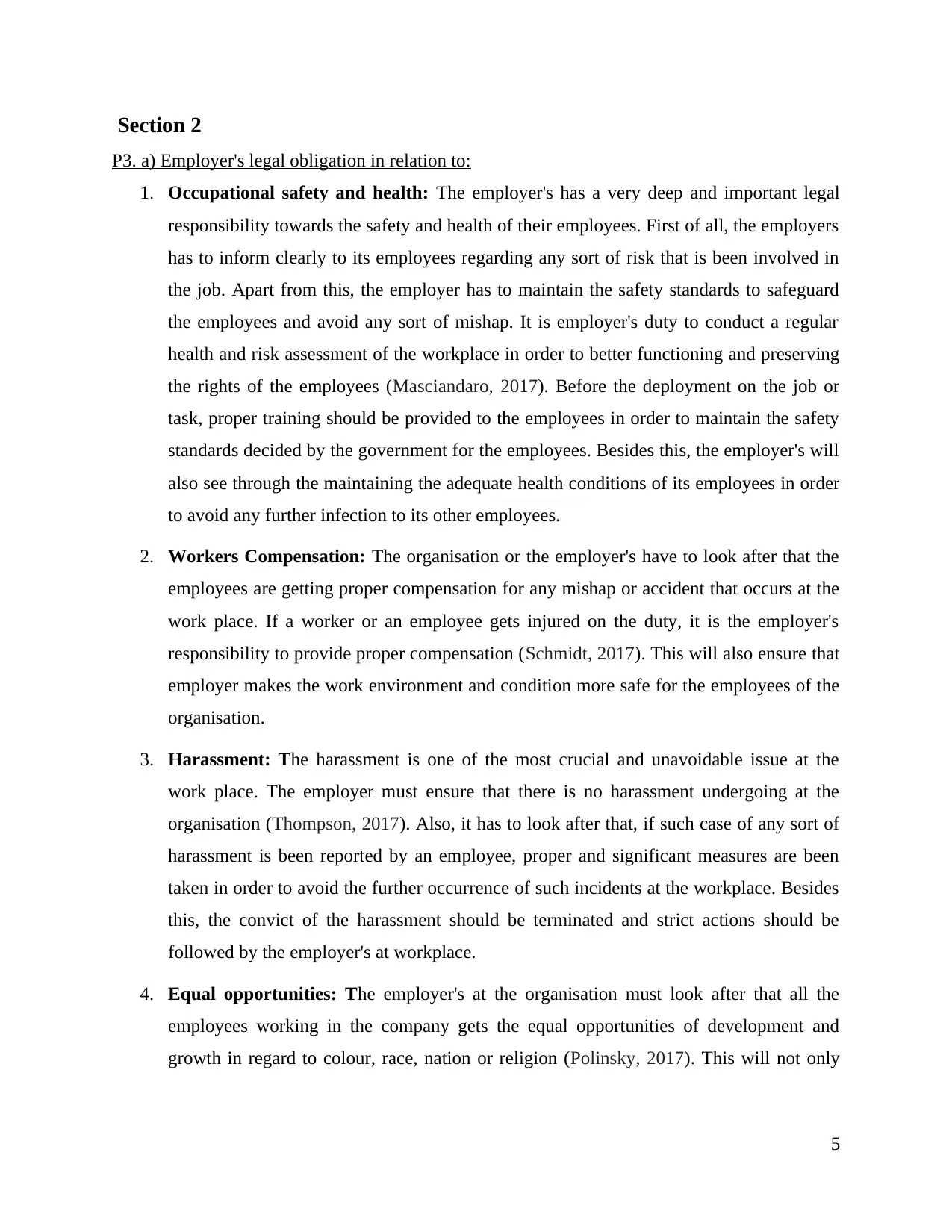
Section 2
P3. a) Employer's legal obligation in relation to:
1. Occupational safety and health: The employer's has a very deep and important legal
responsibility towards the safety and health of their employees. First of all, the employers
has to inform clearly to its employees regarding any sort of risk that is been involved in
the job. Apart from this, the employer has to maintain the safety standards to safeguard
the employees and avoid any sort of mishap. It is employer's duty to conduct a regular
health and risk assessment of the workplace in order to better functioning and preserving
the rights of the employees (Masciandaro, 2017). Before the deployment on the job or
task, proper training should be provided to the employees in order to maintain the safety
standards decided by the government for the employees. Besides this, the employer's will
also see through the maintaining the adequate health conditions of its employees in order
to avoid any further infection to its other employees.
2. Workers Compensation: The organisation or the employer's have to look after that the
employees are getting proper compensation for any mishap or accident that occurs at the
work place. If a worker or an employee gets injured on the duty, it is the employer's
responsibility to provide proper compensation (Schmidt, 2017). This will also ensure that
employer makes the work environment and condition more safe for the employees of the
organisation.
3. Harassment: The harassment is one of the most crucial and unavoidable issue at the
work place. The employer must ensure that there is no harassment undergoing at the
organisation (Thompson, 2017). Also, it has to look after that, if such case of any sort of
harassment is been reported by an employee, proper and significant measures are been
taken in order to avoid the further occurrence of such incidents at the workplace. Besides
this, the convict of the harassment should be terminated and strict actions should be
followed by the employer's at workplace.
4. Equal opportunities: The employer's at the organisation must look after that all the
employees working in the company gets the equal opportunities of development and
growth in regard to colour, race, nation or religion (Polinsky, 2017). This will not only
5
P3. a) Employer's legal obligation in relation to:
1. Occupational safety and health: The employer's has a very deep and important legal
responsibility towards the safety and health of their employees. First of all, the employers
has to inform clearly to its employees regarding any sort of risk that is been involved in
the job. Apart from this, the employer has to maintain the safety standards to safeguard
the employees and avoid any sort of mishap. It is employer's duty to conduct a regular
health and risk assessment of the workplace in order to better functioning and preserving
the rights of the employees (Masciandaro, 2017). Before the deployment on the job or
task, proper training should be provided to the employees in order to maintain the safety
standards decided by the government for the employees. Besides this, the employer's will
also see through the maintaining the adequate health conditions of its employees in order
to avoid any further infection to its other employees.
2. Workers Compensation: The organisation or the employer's have to look after that the
employees are getting proper compensation for any mishap or accident that occurs at the
work place. If a worker or an employee gets injured on the duty, it is the employer's
responsibility to provide proper compensation (Schmidt, 2017). This will also ensure that
employer makes the work environment and condition more safe for the employees of the
organisation.
3. Harassment: The harassment is one of the most crucial and unavoidable issue at the
work place. The employer must ensure that there is no harassment undergoing at the
organisation (Thompson, 2017). Also, it has to look after that, if such case of any sort of
harassment is been reported by an employee, proper and significant measures are been
taken in order to avoid the further occurrence of such incidents at the workplace. Besides
this, the convict of the harassment should be terminated and strict actions should be
followed by the employer's at workplace.
4. Equal opportunities: The employer's at the organisation must look after that all the
employees working in the company gets the equal opportunities of development and
growth in regard to colour, race, nation or religion (Polinsky, 2017). This will not only
5
Paraphrase This Document
Need a fresh take? Get an instant paraphrase of this document with our AI Paraphraser
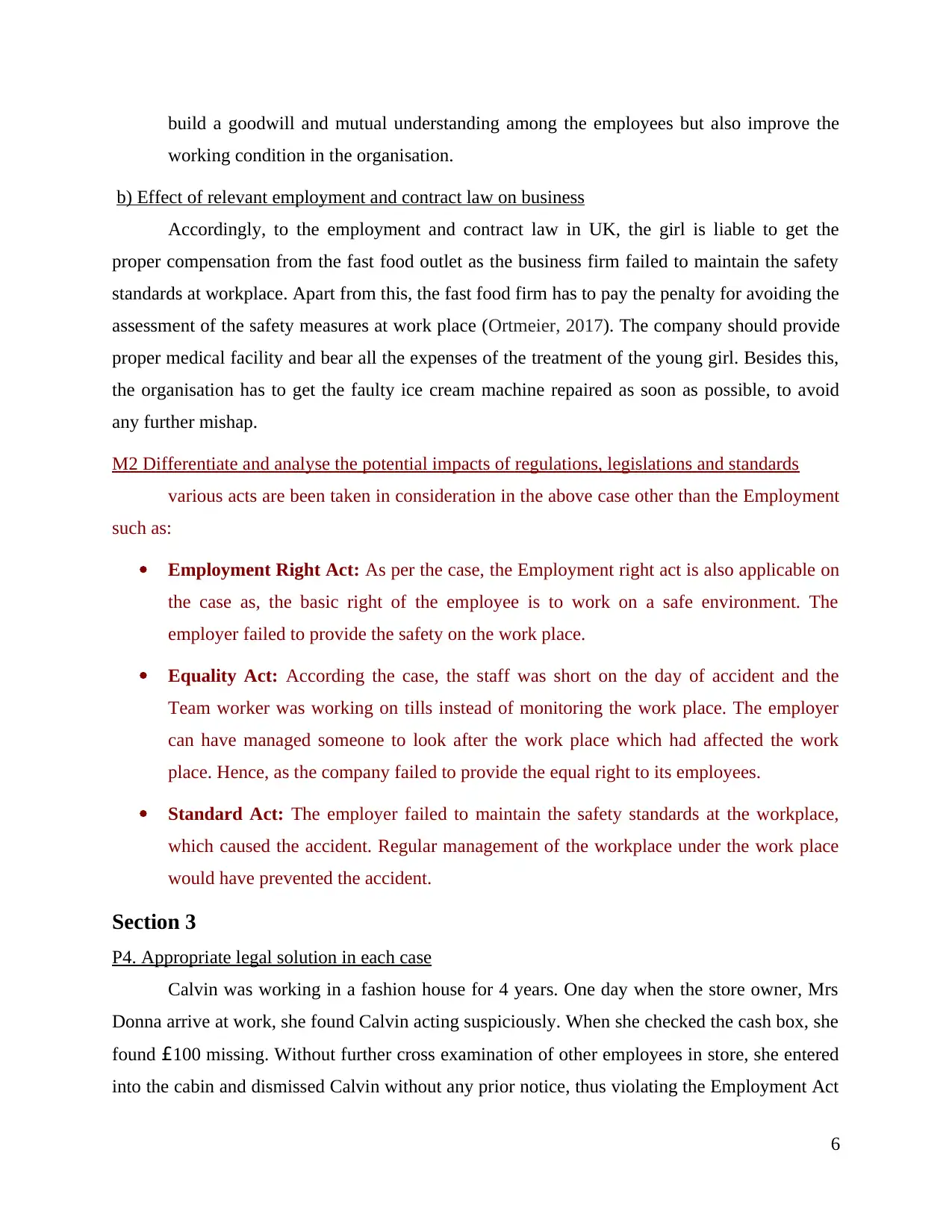
build a goodwill and mutual understanding among the employees but also improve the
working condition in the organisation.
b) Effect of relevant employment and contract law on business
Accordingly, to the employment and contract law in UK, the girl is liable to get the
proper compensation from the fast food outlet as the business firm failed to maintain the safety
standards at workplace. Apart from this, the fast food firm has to pay the penalty for avoiding the
assessment of the safety measures at work place (Ortmeier, 2017). The company should provide
proper medical facility and bear all the expenses of the treatment of the young girl. Besides this,
the organisation has to get the faulty ice cream machine repaired as soon as possible, to avoid
any further mishap.
M2 Differentiate and analyse the potential impacts of regulations, legislations and standards
various acts are been taken in consideration in the above case other than the Employment
such as:
Employment Right Act: As per the case, the Employment right act is also applicable on
the case as, the basic right of the employee is to work on a safe environment. The
employer failed to provide the safety on the work place.
Equality Act: According the case, the staff was short on the day of accident and the
Team worker was working on tills instead of monitoring the work place. The employer
can have managed someone to look after the work place which had affected the work
place. Hence, as the company failed to provide the equal right to its employees.
Standard Act: The employer failed to maintain the safety standards at the workplace,
which caused the accident. Regular management of the workplace under the work place
would have prevented the accident.
Section 3
P4. Appropriate legal solution in each case
Calvin was working in a fashion house for 4 years. One day when the store owner, Mrs
Donna arrive at work, she found Calvin acting suspiciously. When she checked the cash box, she
found £100 missing. Without further cross examination of other employees in store, she entered
into the cabin and dismissed Calvin without any prior notice, thus violating the Employment Act
6
working condition in the organisation.
b) Effect of relevant employment and contract law on business
Accordingly, to the employment and contract law in UK, the girl is liable to get the
proper compensation from the fast food outlet as the business firm failed to maintain the safety
standards at workplace. Apart from this, the fast food firm has to pay the penalty for avoiding the
assessment of the safety measures at work place (Ortmeier, 2017). The company should provide
proper medical facility and bear all the expenses of the treatment of the young girl. Besides this,
the organisation has to get the faulty ice cream machine repaired as soon as possible, to avoid
any further mishap.
M2 Differentiate and analyse the potential impacts of regulations, legislations and standards
various acts are been taken in consideration in the above case other than the Employment
such as:
Employment Right Act: As per the case, the Employment right act is also applicable on
the case as, the basic right of the employee is to work on a safe environment. The
employer failed to provide the safety on the work place.
Equality Act: According the case, the staff was short on the day of accident and the
Team worker was working on tills instead of monitoring the work place. The employer
can have managed someone to look after the work place which had affected the work
place. Hence, as the company failed to provide the equal right to its employees.
Standard Act: The employer failed to maintain the safety standards at the workplace,
which caused the accident. Regular management of the workplace under the work place
would have prevented the accident.
Section 3
P4. Appropriate legal solution in each case
Calvin was working in a fashion house for 4 years. One day when the store owner, Mrs
Donna arrive at work, she found Calvin acting suspiciously. When she checked the cash box, she
found £100 missing. Without further cross examination of other employees in store, she entered
into the cabin and dismissed Calvin without any prior notice, thus violating the Employment Act
6
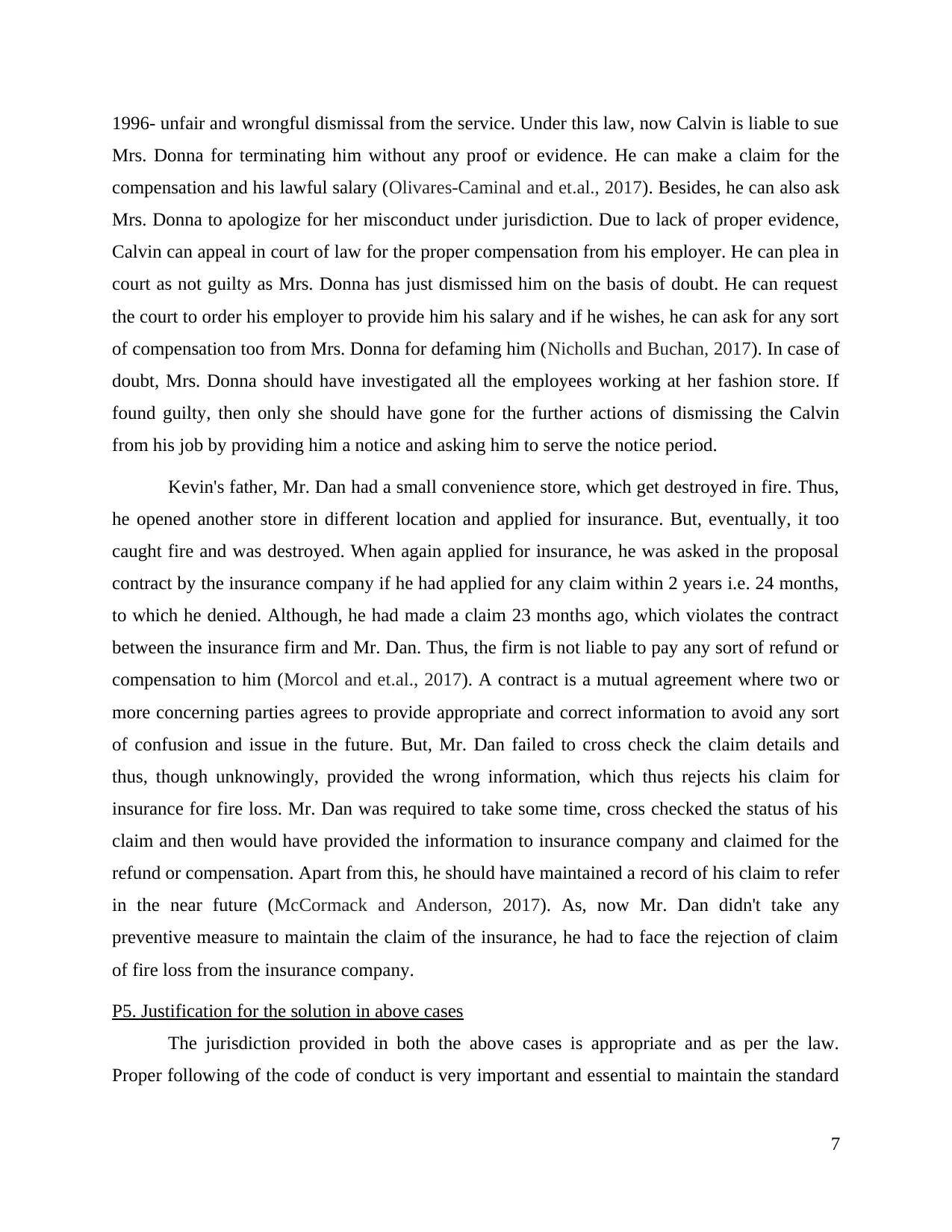
1996- unfair and wrongful dismissal from the service. Under this law, now Calvin is liable to sue
Mrs. Donna for terminating him without any proof or evidence. He can make a claim for the
compensation and his lawful salary (Olivares-Caminal and et.al., 2017). Besides, he can also ask
Mrs. Donna to apologize for her misconduct under jurisdiction. Due to lack of proper evidence,
Calvin can appeal in court of law for the proper compensation from his employer. He can plea in
court as not guilty as Mrs. Donna has just dismissed him on the basis of doubt. He can request
the court to order his employer to provide him his salary and if he wishes, he can ask for any sort
of compensation too from Mrs. Donna for defaming him (Nicholls and Buchan, 2017). In case of
doubt, Mrs. Donna should have investigated all the employees working at her fashion store. If
found guilty, then only she should have gone for the further actions of dismissing the Calvin
from his job by providing him a notice and asking him to serve the notice period.
Kevin's father, Mr. Dan had a small convenience store, which get destroyed in fire. Thus,
he opened another store in different location and applied for insurance. But, eventually, it too
caught fire and was destroyed. When again applied for insurance, he was asked in the proposal
contract by the insurance company if he had applied for any claim within 2 years i.e. 24 months,
to which he denied. Although, he had made a claim 23 months ago, which violates the contract
between the insurance firm and Mr. Dan. Thus, the firm is not liable to pay any sort of refund or
compensation to him (Morcol and et.al., 2017). A contract is a mutual agreement where two or
more concerning parties agrees to provide appropriate and correct information to avoid any sort
of confusion and issue in the future. But, Mr. Dan failed to cross check the claim details and
thus, though unknowingly, provided the wrong information, which thus rejects his claim for
insurance for fire loss. Mr. Dan was required to take some time, cross checked the status of his
claim and then would have provided the information to insurance company and claimed for the
refund or compensation. Apart from this, he should have maintained a record of his claim to refer
in the near future (McCormack and Anderson, 2017). As, now Mr. Dan didn't take any
preventive measure to maintain the claim of the insurance, he had to face the rejection of claim
of fire loss from the insurance company.
P5. Justification for the solution in above cases
The jurisdiction provided in both the above cases is appropriate and as per the law.
Proper following of the code of conduct is very important and essential to maintain the standard
7
Mrs. Donna for terminating him without any proof or evidence. He can make a claim for the
compensation and his lawful salary (Olivares-Caminal and et.al., 2017). Besides, he can also ask
Mrs. Donna to apologize for her misconduct under jurisdiction. Due to lack of proper evidence,
Calvin can appeal in court of law for the proper compensation from his employer. He can plea in
court as not guilty as Mrs. Donna has just dismissed him on the basis of doubt. He can request
the court to order his employer to provide him his salary and if he wishes, he can ask for any sort
of compensation too from Mrs. Donna for defaming him (Nicholls and Buchan, 2017). In case of
doubt, Mrs. Donna should have investigated all the employees working at her fashion store. If
found guilty, then only she should have gone for the further actions of dismissing the Calvin
from his job by providing him a notice and asking him to serve the notice period.
Kevin's father, Mr. Dan had a small convenience store, which get destroyed in fire. Thus,
he opened another store in different location and applied for insurance. But, eventually, it too
caught fire and was destroyed. When again applied for insurance, he was asked in the proposal
contract by the insurance company if he had applied for any claim within 2 years i.e. 24 months,
to which he denied. Although, he had made a claim 23 months ago, which violates the contract
between the insurance firm and Mr. Dan. Thus, the firm is not liable to pay any sort of refund or
compensation to him (Morcol and et.al., 2017). A contract is a mutual agreement where two or
more concerning parties agrees to provide appropriate and correct information to avoid any sort
of confusion and issue in the future. But, Mr. Dan failed to cross check the claim details and
thus, though unknowingly, provided the wrong information, which thus rejects his claim for
insurance for fire loss. Mr. Dan was required to take some time, cross checked the status of his
claim and then would have provided the information to insurance company and claimed for the
refund or compensation. Apart from this, he should have maintained a record of his claim to refer
in the near future (McCormack and Anderson, 2017). As, now Mr. Dan didn't take any
preventive measure to maintain the claim of the insurance, he had to face the rejection of claim
of fire loss from the insurance company.
P5. Justification for the solution in above cases
The jurisdiction provided in both the above cases is appropriate and as per the law.
Proper following of the code of conduct is very important and essential to maintain the standard
7
⊘ This is a preview!⊘
Do you want full access?
Subscribe today to unlock all pages.

Trusted by 1+ million students worldwide
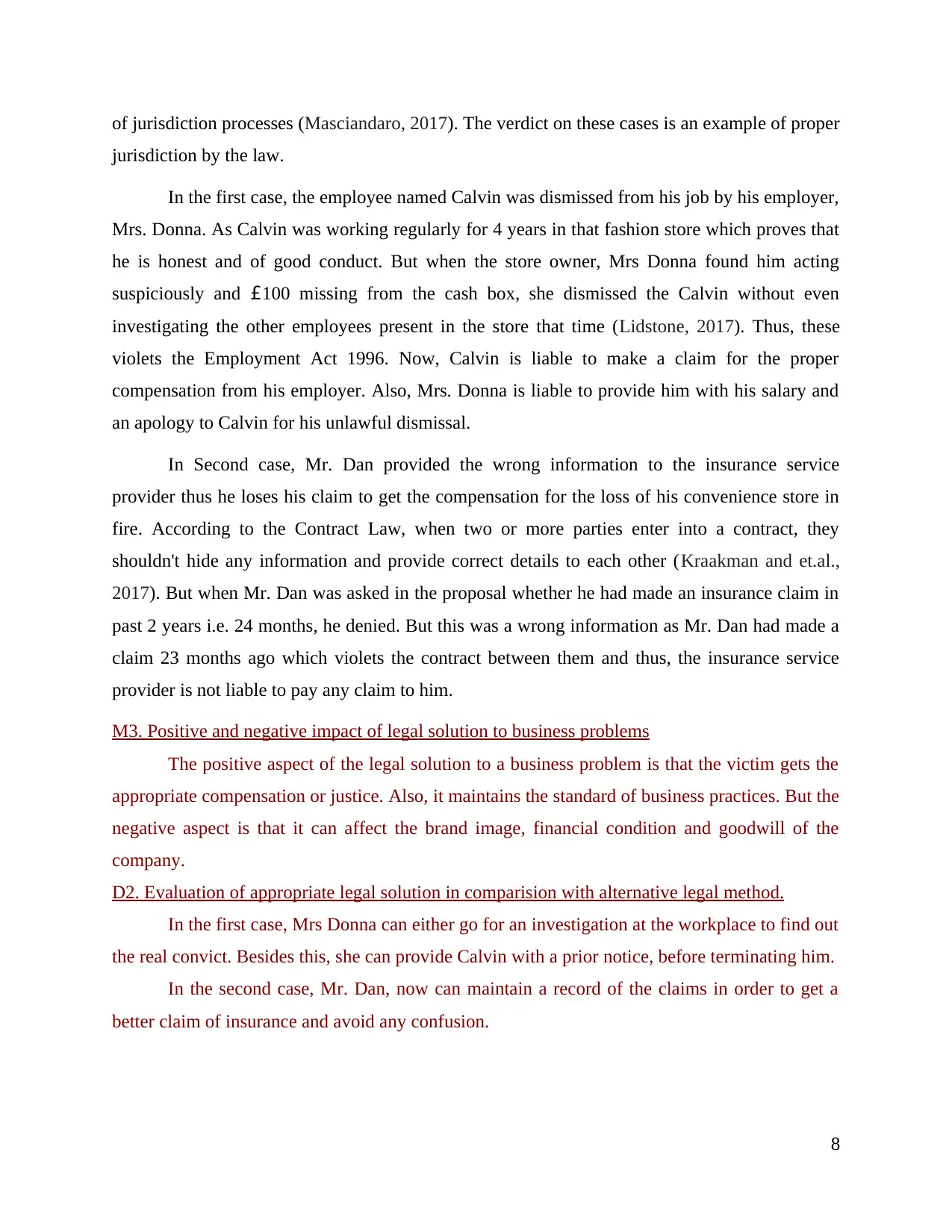
of jurisdiction processes (Masciandaro, 2017). The verdict on these cases is an example of proper
jurisdiction by the law.
In the first case, the employee named Calvin was dismissed from his job by his employer,
Mrs. Donna. As Calvin was working regularly for 4 years in that fashion store which proves that
he is honest and of good conduct. But when the store owner, Mrs Donna found him acting
suspiciously and £100 missing from the cash box, she dismissed the Calvin without even
investigating the other employees present in the store that time (Lidstone, 2017). Thus, these
violets the Employment Act 1996. Now, Calvin is liable to make a claim for the proper
compensation from his employer. Also, Mrs. Donna is liable to provide him with his salary and
an apology to Calvin for his unlawful dismissal.
In Second case, Mr. Dan provided the wrong information to the insurance service
provider thus he loses his claim to get the compensation for the loss of his convenience store in
fire. According to the Contract Law, when two or more parties enter into a contract, they
shouldn't hide any information and provide correct details to each other (Kraakman and et.al.,
2017). But when Mr. Dan was asked in the proposal whether he had made an insurance claim in
past 2 years i.e. 24 months, he denied. But this was a wrong information as Mr. Dan had made a
claim 23 months ago which violets the contract between them and thus, the insurance service
provider is not liable to pay any claim to him.
M3. Positive and negative impact of legal solution to business problems
The positive aspect of the legal solution to a business problem is that the victim gets the
appropriate compensation or justice. Also, it maintains the standard of business practices. But the
negative aspect is that it can affect the brand image, financial condition and goodwill of the
company.
D2. Evaluation of appropriate legal solution in comparision with alternative legal method.
In the first case, Mrs Donna can either go for an investigation at the workplace to find out
the real convict. Besides this, she can provide Calvin with a prior notice, before terminating him.
In the second case, Mr. Dan, now can maintain a record of the claims in order to get a
better claim of insurance and avoid any confusion.
8
jurisdiction by the law.
In the first case, the employee named Calvin was dismissed from his job by his employer,
Mrs. Donna. As Calvin was working regularly for 4 years in that fashion store which proves that
he is honest and of good conduct. But when the store owner, Mrs Donna found him acting
suspiciously and £100 missing from the cash box, she dismissed the Calvin without even
investigating the other employees present in the store that time (Lidstone, 2017). Thus, these
violets the Employment Act 1996. Now, Calvin is liable to make a claim for the proper
compensation from his employer. Also, Mrs. Donna is liable to provide him with his salary and
an apology to Calvin for his unlawful dismissal.
In Second case, Mr. Dan provided the wrong information to the insurance service
provider thus he loses his claim to get the compensation for the loss of his convenience store in
fire. According to the Contract Law, when two or more parties enter into a contract, they
shouldn't hide any information and provide correct details to each other (Kraakman and et.al.,
2017). But when Mr. Dan was asked in the proposal whether he had made an insurance claim in
past 2 years i.e. 24 months, he denied. But this was a wrong information as Mr. Dan had made a
claim 23 months ago which violets the contract between them and thus, the insurance service
provider is not liable to pay any claim to him.
M3. Positive and negative impact of legal solution to business problems
The positive aspect of the legal solution to a business problem is that the victim gets the
appropriate compensation or justice. Also, it maintains the standard of business practices. But the
negative aspect is that it can affect the brand image, financial condition and goodwill of the
company.
D2. Evaluation of appropriate legal solution in comparision with alternative legal method.
In the first case, Mrs Donna can either go for an investigation at the workplace to find out
the real convict. Besides this, she can provide Calvin with a prior notice, before terminating him.
In the second case, Mr. Dan, now can maintain a record of the claims in order to get a
better claim of insurance and avoid any confusion.
8
Paraphrase This Document
Need a fresh take? Get an instant paraphrase of this document with our AI Paraphraser
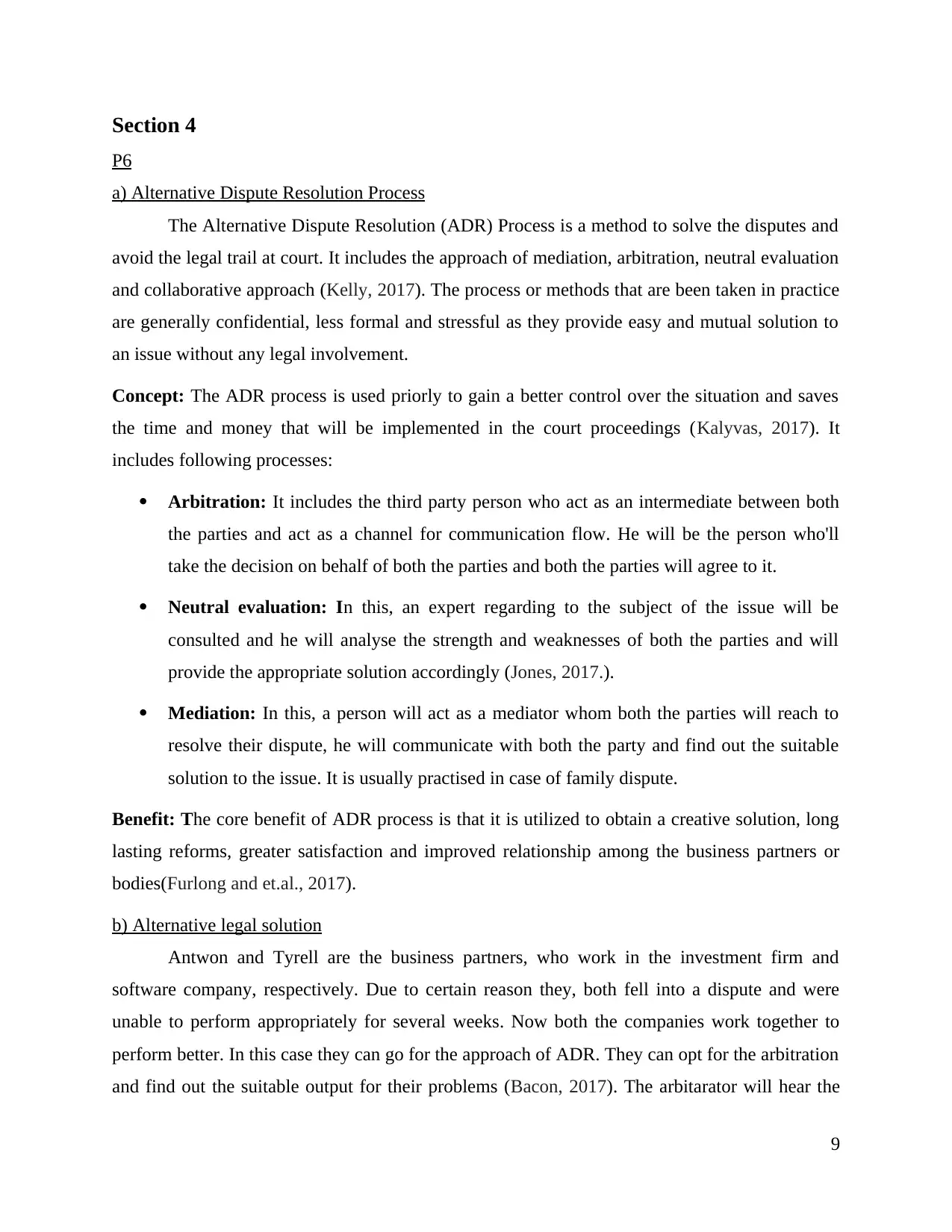
Section 4
P6
a) Alternative Dispute Resolution Process
The Alternative Dispute Resolution (ADR) Process is a method to solve the disputes and
avoid the legal trail at court. It includes the approach of mediation, arbitration, neutral evaluation
and collaborative approach (Kelly, 2017). The process or methods that are been taken in practice
are generally confidential, less formal and stressful as they provide easy and mutual solution to
an issue without any legal involvement.
Concept: The ADR process is used priorly to gain a better control over the situation and saves
the time and money that will be implemented in the court proceedings (Kalyvas, 2017). It
includes following processes:
Arbitration: It includes the third party person who act as an intermediate between both
the parties and act as a channel for communication flow. He will be the person who'll
take the decision on behalf of both the parties and both the parties will agree to it.
Neutral evaluation: In this, an expert regarding to the subject of the issue will be
consulted and he will analyse the strength and weaknesses of both the parties and will
provide the appropriate solution accordingly (Jones, 2017.).
Mediation: In this, a person will act as a mediator whom both the parties will reach to
resolve their dispute, he will communicate with both the party and find out the suitable
solution to the issue. It is usually practised in case of family dispute.
Benefit: The core benefit of ADR process is that it is utilized to obtain a creative solution, long
lasting reforms, greater satisfaction and improved relationship among the business partners or
bodies(Furlong and et.al., 2017).
b) Alternative legal solution
Antwon and Tyrell are the business partners, who work in the investment firm and
software company, respectively. Due to certain reason they, both fell into a dispute and were
unable to perform appropriately for several weeks. Now both the companies work together to
perform better. In this case they can go for the approach of ADR. They can opt for the arbitration
and find out the suitable output for their problems (Bacon, 2017). The arbitarator will hear the
9
P6
a) Alternative Dispute Resolution Process
The Alternative Dispute Resolution (ADR) Process is a method to solve the disputes and
avoid the legal trail at court. It includes the approach of mediation, arbitration, neutral evaluation
and collaborative approach (Kelly, 2017). The process or methods that are been taken in practice
are generally confidential, less formal and stressful as they provide easy and mutual solution to
an issue without any legal involvement.
Concept: The ADR process is used priorly to gain a better control over the situation and saves
the time and money that will be implemented in the court proceedings (Kalyvas, 2017). It
includes following processes:
Arbitration: It includes the third party person who act as an intermediate between both
the parties and act as a channel for communication flow. He will be the person who'll
take the decision on behalf of both the parties and both the parties will agree to it.
Neutral evaluation: In this, an expert regarding to the subject of the issue will be
consulted and he will analyse the strength and weaknesses of both the parties and will
provide the appropriate solution accordingly (Jones, 2017.).
Mediation: In this, a person will act as a mediator whom both the parties will reach to
resolve their dispute, he will communicate with both the party and find out the suitable
solution to the issue. It is usually practised in case of family dispute.
Benefit: The core benefit of ADR process is that it is utilized to obtain a creative solution, long
lasting reforms, greater satisfaction and improved relationship among the business partners or
bodies(Furlong and et.al., 2017).
b) Alternative legal solution
Antwon and Tyrell are the business partners, who work in the investment firm and
software company, respectively. Due to certain reason they, both fell into a dispute and were
unable to perform appropriately for several weeks. Now both the companies work together to
perform better. In this case they can go for the approach of ADR. They can opt for the arbitration
and find out the suitable output for their problems (Bacon, 2017). The arbitarator will hear the
9
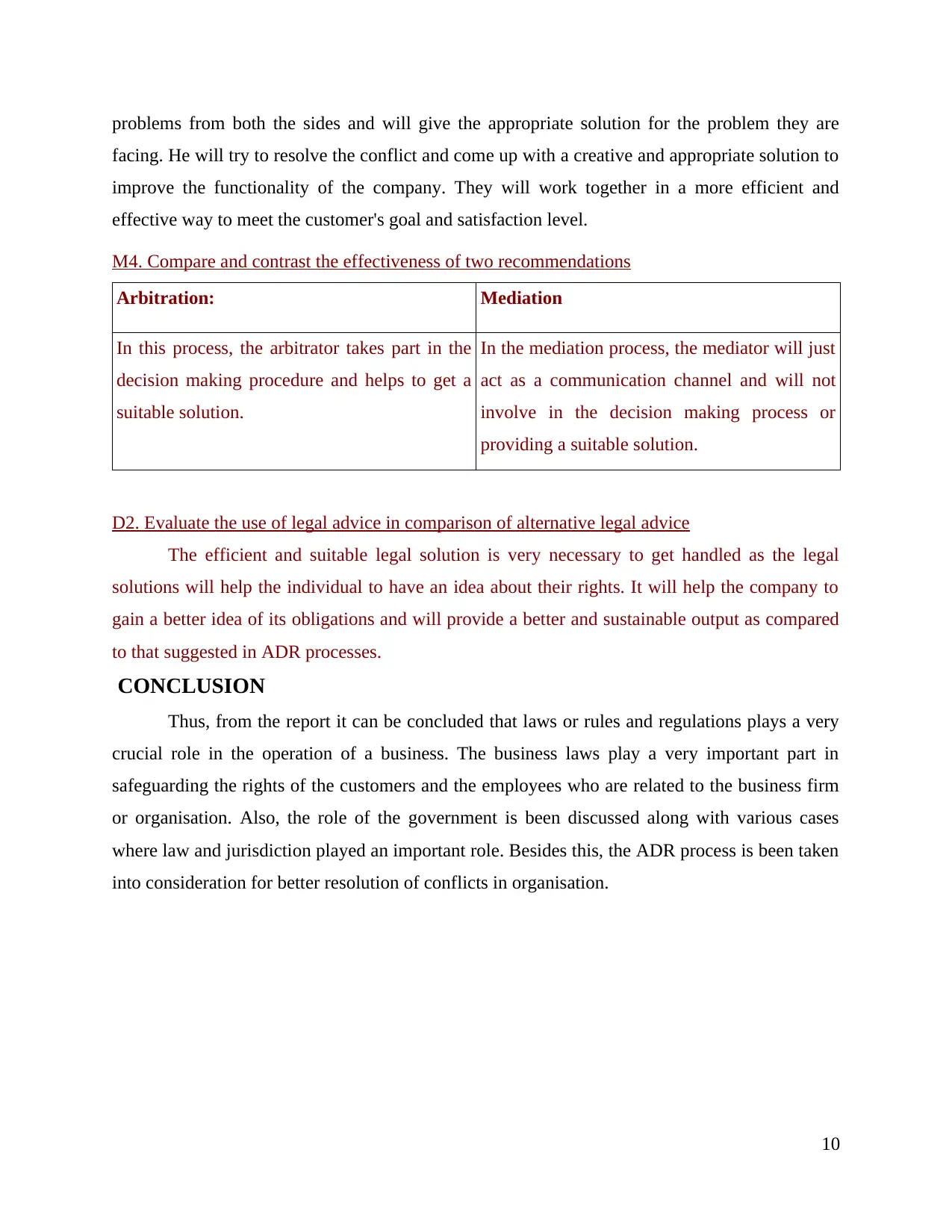
problems from both the sides and will give the appropriate solution for the problem they are
facing. He will try to resolve the conflict and come up with a creative and appropriate solution to
improve the functionality of the company. They will work together in a more efficient and
effective way to meet the customer's goal and satisfaction level.
M4. Compare and contrast the effectiveness of two recommendations
Arbitration: Mediation
In this process, the arbitrator takes part in the
decision making procedure and helps to get a
suitable solution.
In the mediation process, the mediator will just
act as a communication channel and will not
involve in the decision making process or
providing a suitable solution.
D2. Evaluate the use of legal advice in comparison of alternative legal advice
The efficient and suitable legal solution is very necessary to get handled as the legal
solutions will help the individual to have an idea about their rights. It will help the company to
gain a better idea of its obligations and will provide a better and sustainable output as compared
to that suggested in ADR processes.
CONCLUSION
Thus, from the report it can be concluded that laws or rules and regulations plays a very
crucial role in the operation of a business. The business laws play a very important part in
safeguarding the rights of the customers and the employees who are related to the business firm
or organisation. Also, the role of the government is been discussed along with various cases
where law and jurisdiction played an important role. Besides this, the ADR process is been taken
into consideration for better resolution of conflicts in organisation.
10
facing. He will try to resolve the conflict and come up with a creative and appropriate solution to
improve the functionality of the company. They will work together in a more efficient and
effective way to meet the customer's goal and satisfaction level.
M4. Compare and contrast the effectiveness of two recommendations
Arbitration: Mediation
In this process, the arbitrator takes part in the
decision making procedure and helps to get a
suitable solution.
In the mediation process, the mediator will just
act as a communication channel and will not
involve in the decision making process or
providing a suitable solution.
D2. Evaluate the use of legal advice in comparison of alternative legal advice
The efficient and suitable legal solution is very necessary to get handled as the legal
solutions will help the individual to have an idea about their rights. It will help the company to
gain a better idea of its obligations and will provide a better and sustainable output as compared
to that suggested in ADR processes.
CONCLUSION
Thus, from the report it can be concluded that laws or rules and regulations plays a very
crucial role in the operation of a business. The business laws play a very important part in
safeguarding the rights of the customers and the employees who are related to the business firm
or organisation. Also, the role of the government is been discussed along with various cases
where law and jurisdiction played an important role. Besides this, the ADR process is been taken
into consideration for better resolution of conflicts in organisation.
10
⊘ This is a preview!⊘
Do you want full access?
Subscribe today to unlock all pages.

Trusted by 1+ million students worldwide
1 out of 14
Related Documents
Your All-in-One AI-Powered Toolkit for Academic Success.
+13062052269
info@desklib.com
Available 24*7 on WhatsApp / Email
![[object Object]](/_next/static/media/star-bottom.7253800d.svg)
Unlock your academic potential
Copyright © 2020–2025 A2Z Services. All Rights Reserved. Developed and managed by ZUCOL.





